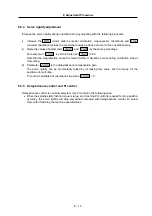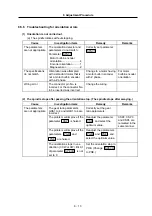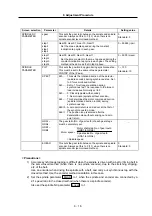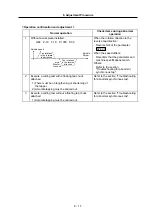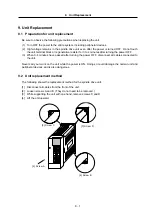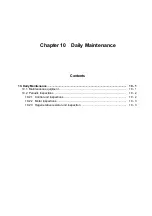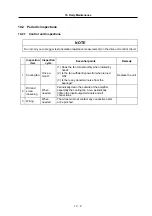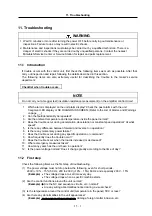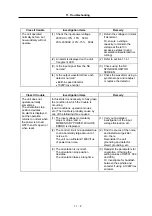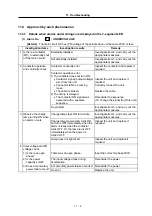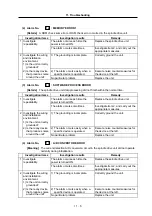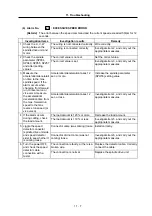
11. Troubleshooting
11
−
1
11. Troubleshooting
WARNING
1. Wait 10 minutes or more after turning the power OFF before carrying out maintenance or
inspections. Failure to do so may result in electric shocks.
2. Maintenance and inspections must always be carried out by a qualified technician. There is a
danger of electric shocks if they are carried out by unqualified persons. Contact the nearest
Mitsubishi Service Center or Service Station for repair and parts replacement.
11.1 Introduction
If trouble occurs with the control unit, first check the following items as much as possible. After that,
carry out inspection and repair following the details described in this section.
The following items are also extremely useful for describing the trouble to the maker's service
department.
Checklist when trouble occurs.
NOTE
Do not carry out a megger test (insulation resistance measurement) on the amplifier control circuit.
1. Which alarm is displayed on the unit alarm display? Check the past alarms with the unit
7-segment LED display or NC DIAGNOSIS SCREEN. (Refer to the List of Alarms and Warnings
on page __.)
2. Can the fault/abnormality be repeated?
3. Are the ambient temperature and temperature inside the panel normal?
4. Does the trouble occur during acceleration, deceleration or constant speed operation? At what
speed?
5. Is there any difference between forward and reverse run operation?
6. Is there any momentary power failure?
7. Does the trouble occur during any specific operation or command?
8. How frequently does the trouble occur?
9. Does the trouble occur when the load is increased or decreased?
10. Where emergency measures taken?
11. How many years has the unit been in operation?
12. Is the power voltage normal? Does it change greatly according to the time of day?
11.2 First step
Check the following items as the first step of troubleshooting.
(1) The power voltage must not drop below the following, even for short periods:
200V (+10%
−
15%) 50 Hz, 200 to 230V (+10%
−
15%) 60Hz, and especially 200V
−
15%
(Example)
•
The voltage drops at a set time every day.
•
The voltage drops when a specific machine starts.
(2) Are the control functions around the unit normal?
(Example)
•
Are the NC and sequence circuits, etc., normal?
•
Are any wiring abnormalities noticed during a visual check?
(3) Is the temperature around the control unit (temperature in the panel) 55
°
C or less?
(4) Are there any abnormalities in the unit appearance?
(Example)
Loose connection connectors, damage, foreign matter intrusion, etc.

